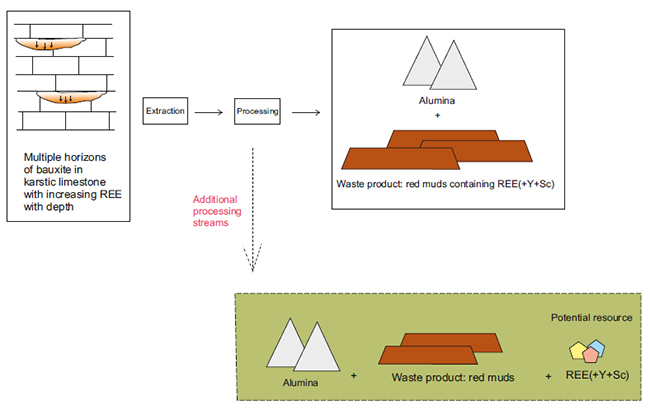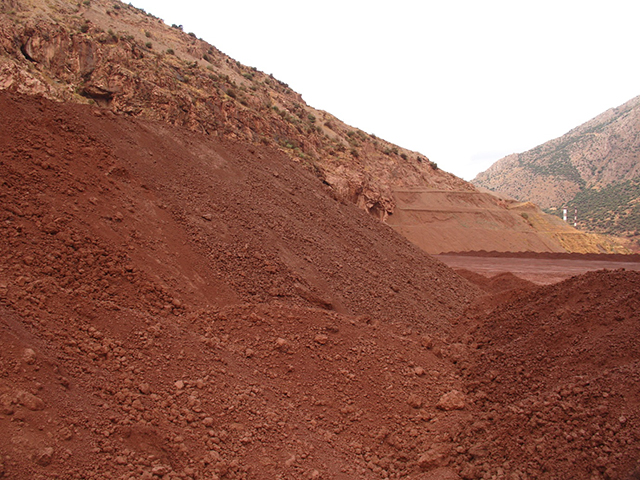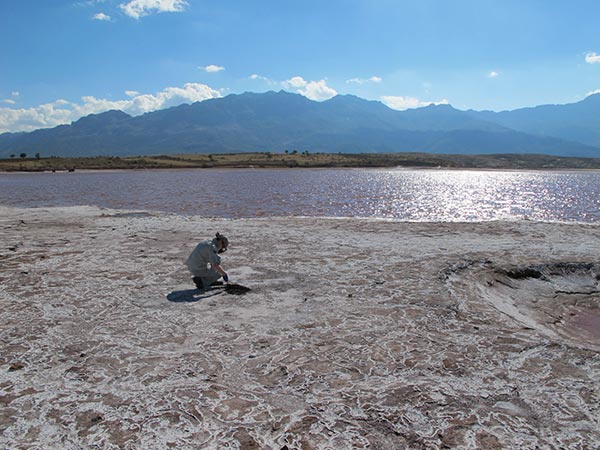REE Mineralisation in circum-Mediterranean Bauxites
Bauxite is formed from the intense lateritic weathering of residual clays, which accumulate in topographic lows on continental surfaces. Bauxite is the primary source for aluminium (Al) production globally and is relatively common in Europe, with deposits known from the majority of Mediterranean countries and intermittent exploitation occurring over many decades.
Rare earth elements in bauxites have been recorded and studied since early researchers in the 1970s identified authigenic minerals occurring in lower layers of bauxites in the San Giovanni Rotondo bauxite in Italy (Bárdossy and Pantó, 1973). Since then, there have been many studies on the process of extracting REE, Y and Sc from red muds produced by processing of bauxites for aluminium. Where REE enriched bauxites are processed to alumina through the Bayer process, the REE have 100% conveyance through to the red mud waste product. It is possible, with the development of appropriate processing streams, that REE could be extracted from the red mud waste that is produced from the Bayer process.
Potential for REE Mineralisation
Of the Mediterranean deposits, those in Greece are of the most economic importance, but other key occurrences are found at Mortaş and Doğankuzu, Turkey Vlasenica in Bosnia Herzgovina, Nikšić, Montenegro and Grebnik, Kosovo. Average REE concentrations of up to 1320 ppm (Nikšić , Montenegro) and 1450 ppm (Grebnik, Kosovo) have been recorded in bauxites (Maksimović and Pantó, 1996 and references therein).
In Greece, exploitable deposits of bauxites exist mainly in the regions of Mt Parnassus, Mt Ghiona and Mt Helikon (central Greece) and on Evia Island. Bauxite reserves are approximately 70Mt — the 9th largest bauxite reserves globally. These deposits are currently exploited for aluminium by a number of producers. Tsirambides and Filippidis (2012) report total REE values in the bauxites and lateritic bauxites of central Greece as 3275 to 6378 ppm. Although these concentrations are significant, they are unlikely to be reflective of all Greek bauxite deposits. High values are likely to result from the sampling of localised areas with REE enrichment along the footwall limestone, and are not representative of average REE concentrations in the bauxite.
REE are concentrated in the red mud waste generated by alumina production from bauxite through the Bayer process. In Turkey, the red mud waste from the Mortaş and the Doğankuzu bauxites was shown to contain an average of 1000 ppm of REE (Deady et al., 2016).
If appropriate processing streams could be developed, this could represent a potential resource in Europe, where 3.8 Mt of bauxite are extracted and processed annually (2015 data, BGS, 2017). In Greece alone, 1.8 Mt of bauxite are extracted and processed, resulting in 900 000 t of red muds annually (2015 data, BGS, 2017).
Key references
Bárdossy, G and Pantó, G. 1996 Trace mineral and element investigation on bauxites by electron probe. 3rd International Congress, ICSOBA, (International Committee for Study of Bauxite, Alumina & Aluminium), Nice, France pp. 47–53 1973.
Maksimović, Z and Pantó, G. Authigenic rare earth minerals in karst-bauxites and karstic nickel deposits. In: A.P. Jones, F. Wall and C T Williams, Rare earth minerals, chemistry, origin and ore deposits, Chapter 10, 257–279.
Tsirambides, A and Filippidis, A. Metallic mineral resources of Greece. 2012. Central European Journal of Geosciences, 4 (4), 641–650.
Deady, E A, Mouchos, E, Goodenough, K M, Williamson, B J, Wall, F. 2016. A review of the potential for rare-earth element resources from European red muds: examples from Seydisehir, Turkey and Parnassus-Giona, Greece. Mineralogical Magazine 80, 43–61.
Brown, T, Idoine, N, Raycraft, E, Shaw, R, Deady, E, Rippingale, J, Bide, T, Wrighton, C, Rodley, J. World Mineral Production 2011–15. British Geological Survey, Keyworth, Nottingham, 2017.




